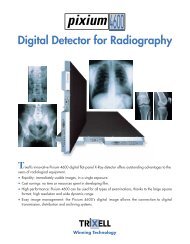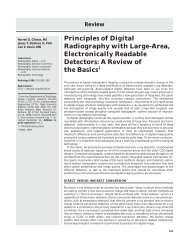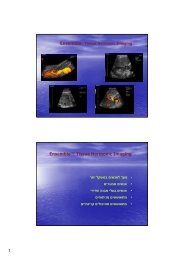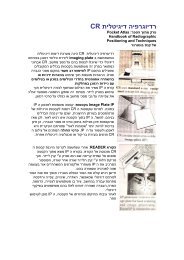Breast anatomy: the basis for understanding sonography
Breast anatomy: the basis for understanding sonography
Breast anatomy: the basis for understanding sonography
You also want an ePaper? Increase the reach of your titles
YUMPU automatically turns print PDFs into web optimized ePapers that Google loves.
<strong>Breast</strong> <strong>anatomy</strong>:<br />
<strong>the</strong> <strong>the</strong> <strong>basis</strong> <strong>for</strong> <strong>for</strong><br />
<strong>understanding</strong> <strong>sonography</strong><br />
.Naomi Weisenberg, M.D<br />
<strong>Breast</strong> Imaging Department<br />
Meir Hospital
The breast is a modified skin gland.<br />
It extends between <strong>the</strong> clavicle and<br />
<strong>the</strong> 8 th<br />
th rib.<br />
Medially reaches <strong>the</strong> sternum and<br />
.laterally <strong>the</strong> midaxillary line
The breast is divided<br />
into incomplete compartments<br />
: by connective tissue<br />
<strong>the</strong> Cooper’s ligaments
The breasts develop from <strong>the</strong><br />
mammary ridges in <strong>the</strong> 5 th<br />
of gestation.<br />
th week<br />
These ridges extend from <strong>the</strong><br />
.axilla to <strong>the</strong> groin
Usually only <strong>the</strong> middle portion<br />
of <strong>the</strong> upper third<br />
of <strong>the</strong> mammary line remains.<br />
Accessory breast tissue may<br />
appear along .” “ <strong>the</strong> milk line
In <strong>the</strong> newborn <strong>the</strong>re is<br />
a simple network<br />
of branching ducts.<br />
Lobules appear only in <strong>the</strong><br />
.adolescence
Complete maturation of<br />
<strong>the</strong> breast may take<br />
place after a full-term<br />
.pregnancy or at age 30
The <strong>Breast</strong> is composed<br />
.of 15 – 20 lobes<br />
Each lobe consists of<br />
numerous lobules and<br />
small branch ducts that join<br />
to <strong>for</strong>m larger ducts until is<br />
only one main subareolar<br />
duct draining <strong>the</strong> whole<br />
.lobe
The functional unit of <strong>the</strong> breast<br />
is <strong>the</strong> TDLU, TDLU,<br />
and is composed of<br />
a lobule and its<br />
.terminal duct
The number of TDLUs TDLU<br />
in <strong>the</strong> breast varies<br />
,from patient to patient<br />
with age, and with<br />
.hormonal influence
Epi<strong>the</strong>lial cells line each<br />
ductule<br />
and are surrounded by<br />
myoepi<strong>the</strong>lial cells that<br />
.contract during lactation
Most breast pathology arises<br />
.within <strong>the</strong> <strong>the</strong> TDLUs<br />
Most ductal carcinomas arise<br />
within <strong>the</strong> terminal duct near<br />
.its junction with <strong>the</strong> lobule
Larger central ducts<br />
give rise only to<br />
intraductal papillomas ,<br />
but may be involved secondarily<br />
by DCIS that grow centrally<br />
from peripherally arising<br />
.cancers
The breast has an extension of<br />
tissue towards <strong>the</strong> axilla<br />
called <strong>the</strong> axillary segment<br />
.or tail
In <strong>the</strong> UOQ is <strong>the</strong> greatest volume<br />
of breast tissue and <strong>the</strong>re is slower<br />
- regression of tissue with age<br />
thus <strong>the</strong> <strong>the</strong> greater number of of<br />
breast lesions appear<br />
.in .in this this quadrant
Each mammary lobe has a fascia that<br />
lies in its anterior surface,<br />
separating it from <strong>the</strong> subcutaneous<br />
fat- Anterior fascia , ,<br />
and a fascia in its posterior surface<br />
that separates <strong>the</strong> lobe from <strong>the</strong><br />
retromammary fat – .Posterior fascia
The Anterior fascia is scalloped<br />
and lies continuous with <strong>the</strong><br />
.Cooper ligaments
A few TDLUs may extend<br />
into <strong>the</strong> Cooper ligaments<br />
in <strong>the</strong> subcutaneous fat.<br />
*A few cancers may arise in<br />
*this location
Lymphatic drainage<br />
of <strong>the</strong> breast<br />
Most of <strong>the</strong> breast lymphatics drain<br />
superficially towards a rich layer of<br />
lymphatics anterior to <strong>the</strong> Anterior<br />
Fascia, <strong>the</strong>n to <strong>the</strong> <strong>the</strong> periareolar<br />
plexus and finally to <strong>the</strong> axilla.<br />
The axillary lymph nodes are <strong>the</strong> most<br />
common site of lymphatic<br />
.involvement
Axillary lymph nodes<br />
are divided into levels<br />
by <strong>the</strong> Pectoralis<br />
.Minor muscle
Axillary dissections<br />
usually involve<br />
level I and II nodes.<br />
Sentinel node involves<br />
only <strong>the</strong> lowest of<br />
.level I nodes
Internal Mammary Lymph<br />
Nodes lie within <strong>the</strong> 2 nd<br />
through 4 th intercostal spaces,<br />
along <strong>the</strong> course of<br />
.<strong>the</strong> internal mammary vessels<br />
nd
The medial part of <strong>the</strong><br />
breast drains<br />
into <strong>the</strong> Internal<br />
.Mammary Nodes
Lymphatic drainage can reach<br />
<strong>the</strong> Supraclavicular Nodes after<br />
first passing through <strong>the</strong><br />
.<br />
Subclavian Nodes
Intramammary lymph nodes<br />
are usually in <strong>the</strong> axillary<br />
segment or lateral quadrant<br />
.of <strong>the</strong> breast
: Nipple and Areola<br />
composed of smooth<br />
muscle fibers and dense<br />
network of nerve<br />
endings
Vascular supply<br />
The lateral thoracic artery<br />
branches from <strong>the</strong> axillary artery<br />
.supplies <strong>the</strong> UOQ
Vascular supply<br />
The medial and central part<br />
of <strong>the</strong> breast<br />
is supplied by branches of<br />
.<strong>the</strong> internal mammary artery
Venous drainage is back<br />
,through <strong>the</strong> axillary<br />
,internal mammary<br />
.and intercostal veins
Supporting structures<br />
Fibrous tissue that courses between<br />
<strong>the</strong> anterior and posterior fascia<br />
represented by<br />
<strong>the</strong> .Cooper’s ligaments
Duct epi<strong>the</strong>lium can be<br />
found directly beneath<br />
<strong>the</strong> dermis and reaching<br />
,<strong>the</strong> pectoralis muscle<br />
so even complete mastectomy<br />
..<br />
does not not remove all all <strong>the</strong> <strong>the</strong> ducts
SCREENING<br />
MAMMOGRAPHY<br />
TWO VIEW<br />
POSITIONING<br />
OBLIQUE AND CRANIO-<br />
CAUDAL FILM
Mammographic<br />
positioning
The technologist must strive to<br />
work with <strong>the</strong> patient to position<br />
<strong>the</strong> breast as completely over<br />
<strong>the</strong> imaging field as possible to<br />
.avoid missing deep tissues
The breast must be<br />
appropriately<br />
compressed<br />
to spread<br />
.overlapping structures
Compression prevents motion,<br />
spreads overlapping structures,<br />
reduces scatter by reducing <strong>the</strong><br />
thickness of <strong>the</strong> tissue and<br />
.reduces blurring
Analyzing mammograms<br />
Find it Perception<br />
Is it real? Verification<br />
Where is it? Localization<br />
What is it? Analysis<br />
On previous films? Comparison<br />
What should be Proper<br />
done about it? management
:Causes of missed breast cancer<br />
Dense parenchyma*<br />
*Poor positioning<br />
*Poor technique<br />
*Lack of perception<br />
*Incorrect interpretation
Guidelines <strong>for</strong> optimization of<br />
:screening efficacy<br />
properly positioned, high<br />
#<br />
quality mammographic images<br />
#special training of <strong>the</strong><br />
radiologist<br />
#double reading of all<br />
screening mammograms
BIRADS classification of<br />
:breast parenchyma<br />
type 1 – breast almost entirely fat<br />
(75% glandular
Mammography sensitivity is<br />
lower among women under<br />
age of 50, have denser breasts<br />
.or are under HRT
Additional views may be<br />
useful when a suspected<br />
abnormality is detected at<br />
screening or by clinical<br />
.examination
















